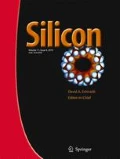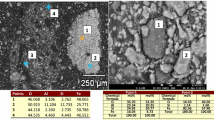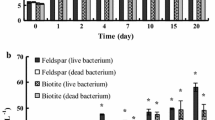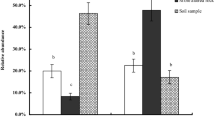Abstract
Silicate solubilisng bacteria (SSB) are distributed in soil, water, aquatic sediments and in silicate minerals but their population is smaller than the total bacteria indicating their uniqueness. Pond sediment showed a higher SSB with 40×104 g−1 while sugarcane field soil recorded 31×104 g−1 dry weight. SSB population in silicate minerals varied with the highest in phyto-sil followed by muscovite but very low in quartz and illite. The silicate solubilisation potential of the six isolates tested on eight minerals varied with the isolates and mineral. Magnesium trisilicate was more easily solubilised than, quartz, or muscovite. Four of the elite isolates were characterized by 16S r RNA sequencing and were found to be Bacillus flexus, B. mucilaginosus, B. megaterium and Pseudomonas fluorescens. The GC/MS analysis of organic acids produced in the medium containing feldspar and quartz by Bacillus flexus and B. muicilaginosus showed variation with the minerals. The release of silica in solution serves as a nutrient for life forms.
Similar content being viewed by others
References
Gadd GM (2010) Metals, minerals and microbes: Geomicrobiology and bioremediation. Microbiology 156:609–643
Webley DM, Henderson MEK, Taylor IF (1963) The microbiology of rocks and weathered stones. J Soil Sci 14:102–112
Northup DE, Lavoie KH (2001) Geomicrobiology of caves: A Review. Geomicrobiol J 18:199–222
Lauwers AM (1974) Biodegradation and utilization of silica and quartz. Arch Microbiol 95:67–78
Sheng XF, Zhao F, He LY, Qiu G, Chen L (2008) Isolation and characterization of silicate mineral – solubilising Bacillus globisporus Q12 from the surfaces of weathered feldspar. Can J Microbiol 54:1064–1068
Uroz S, Calvaruso C, Turpault MP, Frey-Klett PP (2009) Mineral weathering by bacteria: Ecology, actors and mechanisms. Trends Microbiol 17:378–387
Vasanthi N., Saleena LM, Anthoni Raj S (2012) Concurrent release of secondary and micronutrients by a Bacillus sp. American – Eurasian. J Agric Sci 12:1051–1064
Bunt JS, Rovira AD (1955) Microbiological studies of some sustainable soils. J Soil Sci 6:119–128
Imaizumi K, Yoshida S (1958) Edaphological studies on silicon supplying power of paddy fields. Bull Natl Inst Agric Sci Jpn Ser 8:261–304
Barker WW, Banfield JF (1996) Biologically versus inorganically mediated weathering reactions: Relationships between minerals and extracellular microbial polymers in lithobiontic communities. Chem Geol 132:55–69
Lian B, Chen Y, Zhu L (2008) Effect of microbial weathering on carbonate rocks. Earth Sci Front 15:90–99
Waksman SA, Starkey RL (1924) Microbiological analysis of soil as an index of soil fertility. 7. Carbon dioxide evolution. Soil Sci 17:141–161
Pokrovsky O, Shirokova L, Stockman G, Zabelina S, Binizeth P, Gerard E, Menez B, Alfredsson H (2011) Quantifying the role of microorganisms in silicate mineral dissolution at the condition of CO2 storage in basalts. Geophys Res Abstr 13:13904
Avakayan ZA, Pivovarova TA, Karavaiko GI (1986) Properties of new species - Bacillus mucilaginosus. Mikrobiologiya 55:477–482
Drever JI, Stillings LL (1977) The role of organic acids in mineral weathering. Colloids Surf A Physicochem Eng Asp 120:167–181
Duff RB, Webley DM (1959) 2-ketogluconic acid as a natural chelator produced by soil bacteria Chemistry and industry 1376–1377
Kutuzova RS (1969) Release of silica from minerals as a result of microbial activity. Mikrobiologiya 38:596–602
Malinovskaya IM, Kosenko LV, Votselko SK, Podgorskii VS (1990) Role of Bacillus mucilaginosus polysaccharide in degradation of silicate minerals. Mikrobiologiya 59:70–78
Urrutia MM, Beveridge TJ (1994) Formation of fine grained silicate minerals and metal properties by a bacterial cell surface (Bacillus subtilis) and implications on global cycling of silicon. Chem Geol 116:261–280
Ehrlich HL (1981) Geomicrobiology. Marcel Dekker Inc., New York, p 393
Kalinowski BE, Liermann LJ, Brantley SL, Barnes A, Pantano CG (2000) X- ray photoelectron evidence for bacteria – enhanced dissolution of hornblende. Geochim Cosmochim Acta 64:1331–1343
Author information
Authors and Affiliations
Corresponding author
Rights and permissions
About this article
Cite this article
Vasanthi, N., Saleena, L.M. & Raj, S.A. Silica Solubilization Potential of Certain Bacterial Species in the Presence of Different Silicate Minerals. Silicon 10, 267–275 (2018). https://doi.org/10.1007/s12633-016-9438-4
Received:
Accepted:
Published:
Issue Date:
DOI: https://doi.org/10.1007/s12633-016-9438-4




